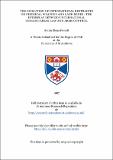Files in this item
The evolution of international restraints on chemical weapons and land mines : the interplay between international humanitarian law and arms control
Item metadata
| dc.contributor.advisor | Wilkinson, Paul | |
| dc.contributor.author | Powell, Maria Elena | |
| dc.coverage.spatial | 322 p. | en_US |
| dc.date.accessioned | 2018-07-13T11:25:02Z | |
| dc.date.available | 2018-07-13T11:25:02Z | |
| dc.date.issued | 1997 | |
| dc.identifier.uri | https://hdl.handle.net/10023/15359 | |
| dc.description.abstract | Weapons are acquired to protect the national security interests of the state: they may be used to settle disputes between one state and another, or they are accumulated as a defensive precaution to dissuade any future or offensive military action. Quite often, weapons are used in great quantities in various internal conflicts to the detriment of the individual, both civilian and combatant. Over time, the international community has developed certain humanitarian principles, norms, treaties and control mechanisms to reduce tensions between states, and to lessen the consequences of unrestrained weapons use. International Humanitarian Law (IHL) or the Law of War seeks to regulate or prohibit the use of particular weapons based on the principle that the means of injuring one's enemies are not unlimited, and that there should be restraints on weapons which are indiscriminate or cause unnecessary suffering. Arms control and disarmament law seeks to limit or even prohibit the use, transfer or trade, production, and stockpiling of certain weapons. There is an interplay between these two approaches when the weapon in question is being restrained because of its perceived nature. Two weapons that have evoked calls for prohibition or restriction because of their pernicious nature are chemical weapons and land mines. Currently, in the Post-Cold War security environment, both these weapons are high on the international political and security agenda rendering them relevant subjects for a comparative study. This thesis examines the respective histories of these regimes of restraint and attempts to determine what lessons may be drawn in comparing efforts to place legal prohibitions on so-deemed inhumane or intolerable weapons. By examining the main similarities and differences in responses to chemical weapons and land mines, it may possible to understand what criteria are necessary for prohibiting a weapon on humanitarian grounds. | en_US |
| dc.language.iso | en | en_US |
| dc.publisher | University of St Andrews | |
| dc.subject.lcc | JX1974.P7 | |
| dc.subject.lcsh | Arms control | en |
| dc.title | The evolution of international restraints on chemical weapons and land mines : the interplay between international humanitarian law and arms control | en_US |
| dc.type | Thesis | en_US |
| dc.type.qualificationlevel | Doctoral | en_US |
| dc.type.qualificationname | PhD Doctor of Philosophy | en_US |
| dc.publisher.institution | The University of St Andrews | en_US |
This item appears in the following Collection(s)
Items in the St Andrews Research Repository are protected by copyright, with all rights reserved, unless otherwise indicated.

